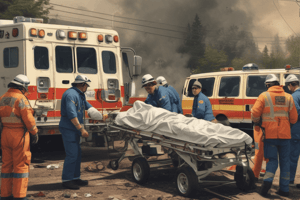Podcast
Questions and Answers
What is the primary responsibility of the Medical Branch Director during a mass casualty incident?
What is the primary responsibility of the Medical Branch Director during a mass casualty incident?
- To document patient conditions for legal purposes
- To evaluate the effectiveness of communication systems
- To oversee ground transportation units
- To ensure triage, extrication, and treatment functions are carried out (correct)
In addition to the Medical Branch Director, which position is NOT typically part of the Medical Branch during a mass casualty incident?
In addition to the Medical Branch Director, which position is NOT typically part of the Medical Branch during a mass casualty incident?
- IMMEDIATE Treatment Sector Officer
- Morgue Officer
- Medical Communications Sector
- Ground Transportation Officer (correct)
How should the Medical Branch communicate its objectives during an incident?
How should the Medical Branch communicate its objectives during an incident?
- By relying on informal communications between team members
- By issuing directives to tactical units and maintaining documentation (correct)
- Through written reports submitted at the end of the incident
- Only verbally during team meetings
Which action is the Medical Branch Director responsible for regarding resources during a mass casualty incident?
Which action is the Medical Branch Director responsible for regarding resources during a mass casualty incident?
What role does the Morgue Officer fulfill within the Medical Branch?
What role does the Morgue Officer fulfill within the Medical Branch?
Flashcards are hidden until you start studying
Study Notes
Medical Branch in Mass Casualty Incidents
- A separate Medical Branch may be required during mass casualty incidents to manage medical operations effectively.
- The Medical Branch operates alongside a Transportation Branch, both reporting to Command.
Responsibilities of the Medical Branch Director
- Ensures triage, extrication, and treatment functions are effectively carried out.
- Supervises and coordinates personnel within the Medical Branch.
- Determines resource needs and requests additional support as necessary.
- Recommends expansions to the command organization to accommodate incident needs.
- Communicates clear directions and objectives to tactical units involved.
- Ensures completion of objectives and maintains thorough incident documentation.
Additional Positions within the Medical Branch
- IMMEDIATE Treatment Sector Officers: Handle critical cases requiring urgent care.
- DELAYED Treatment Sector Officers: Manage cases that need medical attention but are not immediate.
- MINOR Treatment Sector Officers: Oversee minor injuries and less critical cases.
- Medical Communications Sector: Responsible for coordinating communication within the Medical Branch and with other sectors.
- Medical Supply Sector: Manages inventory and distribution of medical supplies.
- Ground Ambulance Coordinator: Oversees transportation of patients to medical facilities.
- Morgue Officer: Responsible for handling deceased individuals and coordinating their management.
Studying That Suits You
Use AI to generate personalized quizzes and flashcards to suit your learning preferences.




